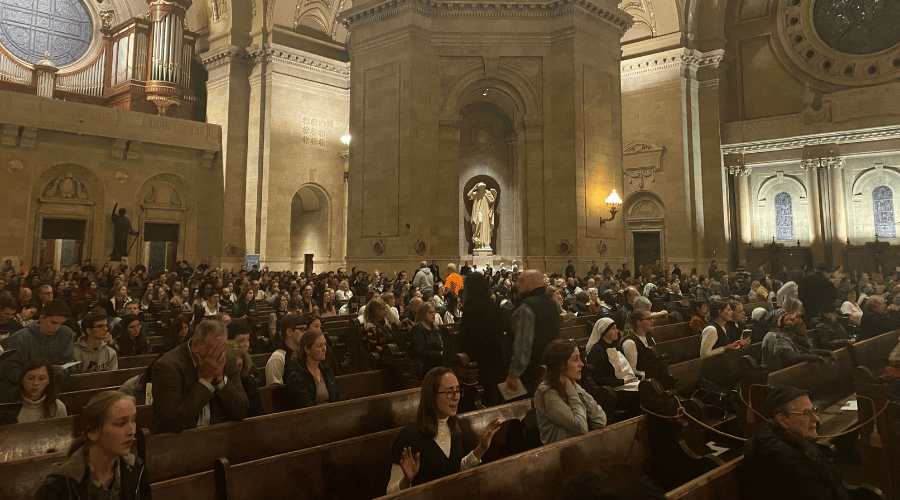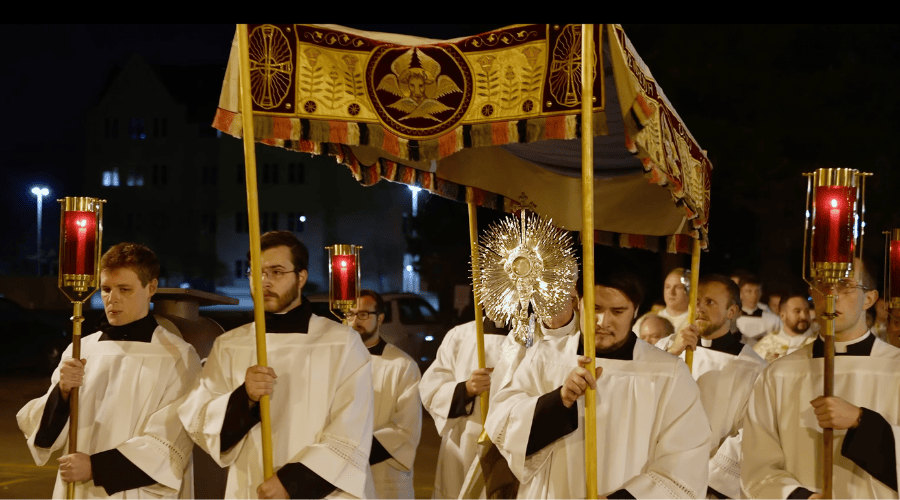Florian, Minnesota doesn’t even show up on Wikipedia’s list of cities in the Land of 10,000 Lakes.
The unincorporated town of 400 is 52 miles straight north of Crookston and about the exact same distance south of the Canadian border. Diocese of Crookston Bishop Andrew Cozzens calls it “a little town with a little Church in the middle of a cornfield.” This is a common setup in Cozzens’ diocese, comprised of 14 counties, 17,000 square miles, 66 parishes and countless farms spread across Northwestern Minnesota.
On a recent visit to Assumption Catholic Church in Florian, Cozzens was approached by an elderly farmer of Polish descent.
“I love what you’re doing with the revival,” the man told the bishop.
“When you’re reaching the old, Polish farmers in Florian, Minnesota, you know you’re starting to get to the grassroots,” Cozzens, a Saint Paul Seminary alum and former auxiliary bishop of the Archdiocese of Saint Paul and Minneapolis, said with a grin.
The renewal referenced is formally called the National Eucharistic Revival, a nationwide movement organized by the United States Conference of Catholic Bishops “to lift up the importance of and strengthen Eucharistic belief in the church in the [U.S.],” according to Cozzens, whom the USCCB tasked with leading the revival. The movement officially began June 19, 2022 on the Feast of Corpus Christi and will culminate with the 10th National Eucharistic Congress from July 17-21, 2024 in Indianapolis.

The first year focused on dioceses, highlighted by multiple Eucharistic processions, Adoration events and catechesis on the Catholic teaching that Jesus is truly present in the Eucharist celebrated at each Mass. This summer kicks off Year 2, which will center more on parish ministry. Year 3 is the “missionary year,” where the national and local Church will seek to equip its members to share the truth of Christ’s Eucharistic presence with those in their broader communities.
“It really is a kind of evangelistic movement,” Cozzens said, “to try to help the average Catholic deepen their own encounter with Jesus in the Eucharist, and then be sent on mission to help share that good news with others.”
Eucharisticrevival.org contains many resources surrounding the revival and the Eucharist, including a free online course from Cozzens where he unpacks “The Mystery of the Eucharist in the Life of the Church.” Users can also sign up for a regular email newsletter full of reflections and information on the Eucharist.
In 2019, the Pew Research Center concluded from a survey that only about 1/3 of U.S. Catholics believe in transubstantiation, the change that happens to the bread and wine when a priest asks God to transform its substance into Jesus’ Body and Blood during the Catholic liturgy. The revival was born in part as a response to this figure, but movement leaders will tell you it’s about more than just changing metrics.
“That’s a startling statistic,” said Fr. Tim Tran, a 2020 Saint Paul Seminary alum and point person for the Archdiocese of Saint Paul and Minneapolis’ revival activities. “It can be so easy to just look at numbers, and forget that behind those numbers are persons, and that’s the beauty of our faith is that it’s rooted in a personal God. … You just look at all the movements in the past; we don’t have statistics on those such as the Franciscan Order, the Dominican Order, the Jesuits, all those wonderful movements that were just organic. And those saints themselves did not set out to reverse some sort of social trend, right? They just set out because they saw a need, and they responded, and they just lived their life in such a radical and attractive way.”
That’s the deeper intended fruit of the Eucharistic revival, Church leaders say.
And seminaries are expected to play a leading role.
The Eucharistic life of the seminary
The word seminary comes from the Latin term for “seed bed,” a place where young men can grow to become holy, healthy and joyful priests.
“You can’t understand the priesthood apart from the Eucharist; they were created together at the Last Supper,” said Cozzens, who lived at The Saint Paul Seminary during his time as auxiliary professor and priest formator there from 2006-13.
“Together they, in a certain way, form one mystery, which is Jesus making Himself present for the life of the world. The priest, his whole life is marked by the daily celebration of the Eucharist and by the transformation that’s happening in him, and he learns who he is from the Eucharist.
“The priest learns that I’m to be given for the sake of my people.”
“Everything that’s going on, all the nitty-gritty of [Catholics’] daily lives, the suffering, the pain, the joys, the triumphs, everything in between, that’s all being offered.” — Deacon Eric Cooley, Director, Saint Paul Seminary Institute for Diaconate Formation
At The Saint Paul Seminary, seminarians begin their day at 6:30 a.m. with a Eucharistic Holy Hour.
Mass is at 11:45 a.m., and many seminarians say night prayer in the chapel, as well. Tentpole events throughout the year include the annual Borromeo Weekend, a joint Eucharistic procession with Saint John Vianney College Seminary across the University of St. Thomas campus followed by 40 hours of perpetual Adoration.
The weekend commemorates St. Charles Borromeo, the patron saint of seminarians.
“Our schedule kind of rotates around the chapel and around prayer,” said Fr. Wil Kratt, a former Saint Paul-Minneapolis seminarian ordained this spring. “There’s always something central about daily routines and always coming back to something. And besides that, everything we learn, everything we’re taught … can somehow be tied back to the Eucharist, to Christ’s presence among His people.”
The seminary also forms deacons and lay leaders.
Diaconate formation days always begin with Mass and include many hours of Eucharistic Adoration. In January, the seminary’s deacon candidates spent 3-4 hours a day in Adoration during a retreat.
“Liturgically, it’s proper to the deacon to prepare the altar,” said Deacon Eric Cooley, the seminary’s director of the Institute for Diaconate Formation. “Which, at face value kind of looks purely practical. It just gives Father a break, right? But there’s something deeper that’s going on, actually … because what [the gifts of bread and wine] actually symbolize are the people [in the pews], their own self-offering.
“Everything that’s going on, all the nitty-gritty of their daily lives, the suffering, the pain, the joys, the triumphs, everything in between, that’s all being offered. The deacon is the one that receives that and is now preparing that to be offered to the Father.”
And whether it’s one of the seminary’s lay graduate programs, preparing the next crop of Catholic school principals or general catechetical studies, The Saint Paul Seminary puts the Eucharist at the center of lay formation, too.
“The Eucharist really points to the way in which the redemptive mission of Christ is kind of translated to us in our own time and our own circumstances,” said Dr. John Froula, associate professor of dogmatic theology and director of the seminary’s Master of Arts in Pastoral Leadership program. “We can look at the sacraments and especially the Eucharist as a kind of instrumental extension of Christ’s saving work.”
A tangible manifestation of these supernatural truths takes place the first Friday of each month at at The Saint Paul Seminary. At Cor Jesu, seminarians lead the University of St. Thomas community and local young adults in an evening of Adoration, praise and worship and contemplation of Christ in the monstrance.
A larger-scale version of Cor Jesu was held in conjunction with the Eucharistic Revival at the Cathedral of St. Paul in November. More than 1,200 Catholics from around Minnesota gathered to adore Jesus and venerate first-class relics of Blessed Carlo Acutis and St. Manuel González García.
Acutis is best known for documenting global Eucharistic miracles online before his death from leukemia. García is known as “The Bishop of the Tabernacle” due to his Eucharistic devotion.
A celebration for the ages
Leading up to the Eucharistic Congress, four separate Eucharistic processions will begin the weekend of May 18. One leg of this National Eucharistic Pilgrimage will start at Lake Itasca at the headwaters of the Mississippi River – which is right in Cozzens’ episcopal backyard. It will make a stop on Summit Avenue at The Saint Paul Seminary the weekend of May 24, with more details to be announced in the coming months.
The pilgrimage’s four processions will convene at the congress, held primarily inside Indianapolis’ Lucas Oil Stadium.
Organizers expect at least 75,000 people to participate in Masses, Adoration, talks by the likes of Fr. Mike Schmitz, Bishop Robert Barron, Sr. Miriam James Heidland and Fr. Josh Johnson, and performances by Matt Maher and other renowned musical acts.
The last National Eucharistic Congress in the U.S. took place in 1941 in St. Paul. That day, 80,000 people processed through the rain to the Minnesota State Fairgrounds for Mass and Adoration.
An international congress took place in Philadelphia in 1976. Cardinal Karol Wojtyla joined Mother Teresa of Calcutta on stage as hundreds of thousands of Catholics gathered.
Two years later, Wojtyla became Pope John Paul II.

40 hours of perpetual Adoration is the same one that was used at the last National Eucharistic Congress in 1941.
A lot has changed in the almost five decades since the last Eucharistic congress on American soil. But Jesus’ presence under the appearance of bread and wine remains, Cozzens says.
“It’s going to be, really, a gathering of the U.S. Church that we hope will inspire people to make that missionary conversion,” Cozzens said, “to take home this great encounter that they have with Jesus in the Eucharist.”
And that’s the point. The revival and the Congress are meant to be beginnings, not ends.
“We call it a Eucharistic revival, but what is it that we are reviving?” said Tran, the local point priest for the revival in the Twin Cities. “It can be a wonderful three-year process, which is able to maybe make us excited and maybe elicit a lot of emotion, expending a lot of energy and time and even treasure in terms of financial means, but it might not stick. [It’s] in your own local parishes, with collaboration of your pastor, whatever he has been discerning, that is necessary there to invigorate the spark of our Eucharistic faith for your parishioners.
“[Our] job is to hopefully facilitate that, and to help people discern, to think about some of those questions, to sit back and reflect and allow the Spirit to lead. And we can follow the Lord that way.”
